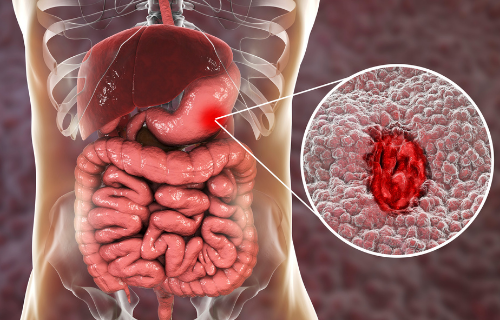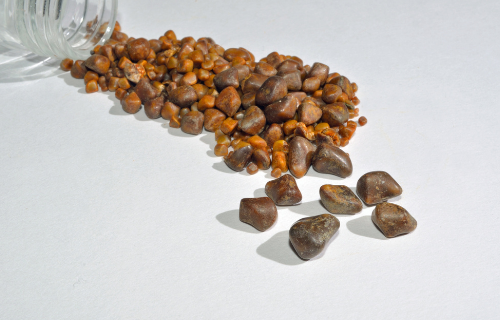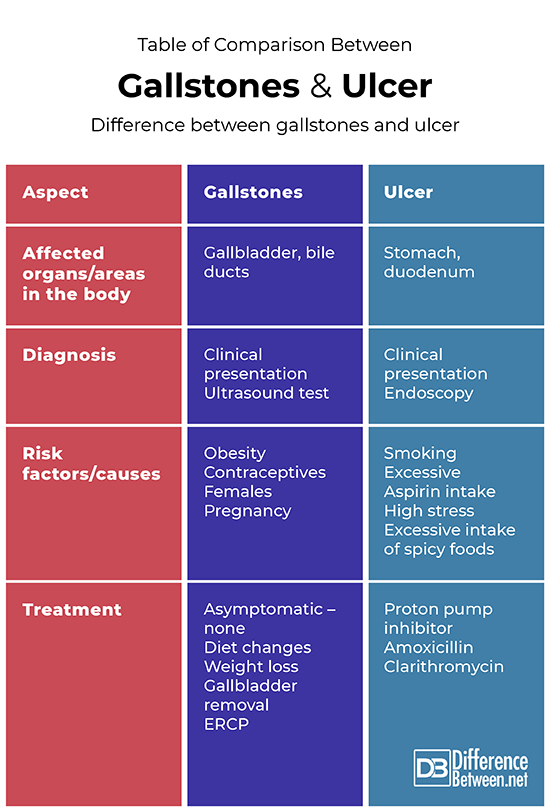Difference Between Gallstones and Ulcer

Gallstones and stomach ulcers are two commonly occurring gastroenterological conditions that can cause a great deal of discomfort in patients. These two conditions can present with similar symptoms; however, the underlying cause and pathology is completely different. Gallstones are formed in the gallbladder and have the ability to move down and cause an obstruction in the bile duct. Ulcers occur in the stomach and in the duodenum (the first part of the small intestine) and can develop to the point of bleeding. Both conditions require medical attention, and the urgency ranges from no treatment to immediate surgery.

Difference between Gallstones and Ulcer
Definition and Pathology
Gallstones (also known as cholelithiasis) are pieces of solid material that form in your gallbladder, a small organ situated just under your liver. The gallbladder stores and releases bile, a fluid made in your liver, to help in digestion of foods. Bile also carries out wastes like cholesterol and bilirubin which your body makes when it breaks down red blood cells. About 70% of people who have gallstones are asymptomatic, but sometimes gallstones can develop to a size that causes symptoms and sometimes urgent health emergencies.
Peptic ulcer disease occurs when there is an imbalance between acid digestion and the defence mechanisms of the mucosa (the inside lining) of the stomach or duodenum. The most common cause is a bacteria called Helicobacter Pylori, as well as the overuse of non-steroidal anti-inflammatories and pain medications such as aspirin.
Symptoms and Clinical Presentation
Gallstone colic is the clinical picture that is presented when there is an impaction of a gallstone in the neck of the gallbladder or in the cystic duct. Gallstone colic has the following clinical picture:
- Sudden onset of pain in the right upper corner of the abdomen (hypochondrium) which often spreads to the right shoulder
- Vomiting
- Patients may sweat during the gallstone attack
- Presence of excruciating pain
- The gallstone attack gradually subsides, and between the attacks the patient is quite healthy
Ulcers, on the other hand, often present with the following symptoms:
- Epigastric pain (pain experienced just beneath the sternum) is the most common symptom of both gastric and duodenal ulcers
- An uncomfortable or burning sensation and occurs after meals. This usually happens shortly after meals for a gastric ulcer and 2-3 hours afterward for a duodenal ulcer
- Foods or antacids relieve the pain of duodenal ulcers but provide very little relief of gastric ulcer pain
Diagnosis and Risk Factors
Diagnosis can usually be made by a physician based on the clinical picture presented and then later confirmed on ultrasound. On an ultrasound image, the stones are usually seen in the gall bladder or in some cases within the ducts that drain from the gall bladder.
The biggest risk factors for gallstones include obesity, the use of oral contraceptive, female gender, and pregnancy.
Much like gallstones, the clinical picture should cause suspicion for an ulcer, which would then include additional testing. These tests include endoscopy with the testing for the presence H. Pylori bacteria.
The biggest risk factors for ulcers include lifestyle habits likes smoking, excessive use of aspirin and other non-steroidal anti-inflammatory medications, high stress levels, and significant consumption of spicy foods.
Treatment
When gallstones present without symptoms, then treatment usually is not required. When symptoms occur, gallstones are usually treated with lifestyle changes and weight loss (to prevent biliary colic). In severe cases the gallbladder may be removed via a procedure referred to as a laparoscopic cholecystectomy. In some cases where the bile duct is blocked, an endoscopic retrograde cholangiopancreatography (ERCP) can be performed.
Treating an ulcer is usually done as a triple-therapy regimen. This includes a proton pump inhibitor to reduce stomach acid secretion inside the stomach, and two different types of antibiotics (amoxicillin and clarithromycin).
Table of comparison between gallstones and ulcer

Summary Gallstones vs Ulcer
Both gallstones and peptic ulcers are notorious for causing great discomfort in a patient’s daily life. There are often many similar symptoms (such as Indigestion, discomfort experienced after eating and decreased quality of life), however in terms of risk factors, treatment and complications the two conditions can be clearly distinguished from one another. Both conditions require medical attention and treatment should always be started earlier rather than later.
FAQ
Can gallstones feel like an ulcer?
Both conditions may have very similar symptoms, and in both cases abdominal discomfort is the most common symptom. Therefore, it might be challenging to initially distinguish between the two. However, it is important to note that gallstone colic is characterised by excruciating pain where ulcer pain is normally dull in nature. So however, gallstones may sometimes feel like an ulcer, it still has a distinct symptom difference.
Can an ulcer mimic a gallbladder attack?
In the rare occasion that an ulcer perforates or ruptures, a patient may also experience an excruciating pain similar to that caused by gallstones. A person with a perforated ulcer will, however, be much more acutely ill than a person experiencing gallstone colic. A peptic ulcer that has perforated needs immediate medical attention.
What does gallstone pain feel like?
Gallstone pain typically occurs after consuming a fatty meal and patients tend to experience dull pain at first in the right upper abdomen which can progress to excruciating pain if the stone obstructs the duct. Nausea and vomiting can also be experienced during such an attack.
Where is ulcer pain located?
Ulcer pain typically starts on the epigastrium or epigastric area (located just below the breastbone) and then radiates to the left upper abdomen. Pain can be accompanied by severe heart burn as well and can be relieved by over-the-counter antacids in most cases.
- Difference Between a Cochlear Implant and Normal Hearing - October 4, 2022
- Difference Between Obstructive and Restrictive Spirometry - September 11, 2022
- The Difference Between White Box and Black Box Testing - September 11, 2022
Search DifferenceBetween.net :
Leave a Response
References :
[0]Gossage, James., Bultitude, Matthew and Corbett, Steven. Browse’s Introduction to the Symptoms & Signs of Surgical Disease. 2021. CRC Press: Florida. pp: 644
[1]O’ Katz, Philip. Peptic Ulcer Disease. 2021. https://emedicine.medscape.com/article/181753-overview?src=mbl_msp_android&ref=share
[2]Heuman, Douglas and Mihas, Anastasios. Gallstones (Cholelithiasis) Treatment & Management. 2019.https://emedicine.medscape.com/article/175667-treatment?src=mbl_msp_android&ref=share
